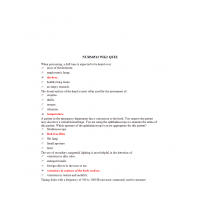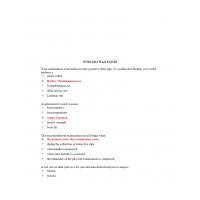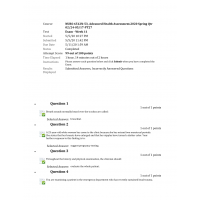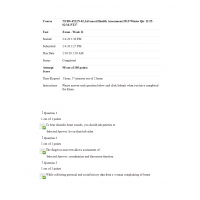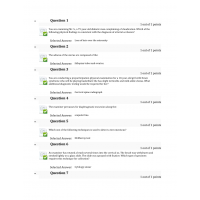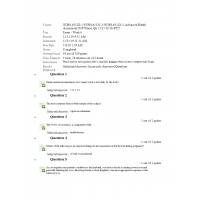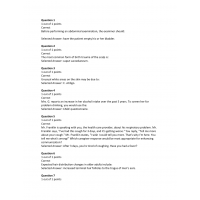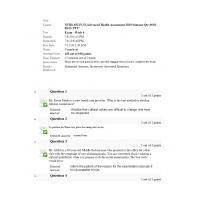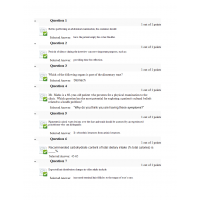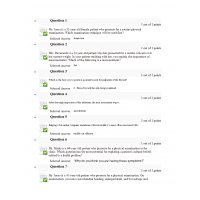NURS 6512N Week 5 Quiz - Advanced Health Assessment
1. A patient has come in with a chief complaint of facial pain and “sinus issues.” Transillumination of the right sinus produces no light. You consulted your preceptor to order a sinus x-ray and she agreed. Which of the following findings on x-ray would support your diagnosis of sinusitis? Air fluid in the Right side
2. Which of the following is not a component of a management plan?
3. Which variation may be an expected finding in the ear examination of a newborn?
4. Nasal symptoms that imply an allergic response include:
5. Observation during history taking is the best way to examine for:
6. The hair cells of Corti and membrane of Corti:
7. Speech with a monotonous tone and erratic volume may indicate:
8. Status epilepticus is defined as:
9. New findings of unknown causes are:
10. During the physical examination of a 30-year-old Chinese man, you notice a slight asymmetry of his face. The cranial nerve examination is normal. Your best action is to:
11. While performing the primary survey on a trauma victim, the patient is answering your questions. You may assume that during the time of the questioning:
12. When examining the skull of a 4-month-old baby, you should normally find:
13. Mr. Black is a 44-year-old patient who presents to the clinic with complaints of neck pain that he thinks is from his job involving computer data entry. As the examiner, you are checking the range of motion in his neck and note the greatest degree of cervical mobility is at:
14. After the subjective and objective data have been prioritized, the next step is to:
15. The premature union of cranial sutures that involves the shape of the head without mental retardation is:
16. Ask the patient to look directly at the light of the ophthalmoscope when you are ready to examine the:
17. Term infants have a visual acuity of about_20_/_400_.
18. Mr. C.'s visual acuity is 20/50. This means that he:
19. A pterygium is more common in people heavily exposed to:
20. The criterion for adequacy of a patient's visual field is:
1. What is the structure that protects the eyes from foreign bodies?
2. Tears flow over the cornea and drain via the lacrimal sac into the...
3. Contraction of which eye structure controls the amount of light that reaches the retina?
4. Contraction or relaxation of the ciliary body:
5. The sensory network of the eye is the:
6. Term infants have a visual acuity of about:
7. At what age does an infant usually develop the ability to distinguish color?
8. An increased level of lysozyme in the tears will occur normally during which life stage?
9. A pregnant woman in her third trimester tells you that her vision has been a little blurred and she thinks she needs to get new contact lenses. You should advise her to:
10. Which of the following is a relatively benign condition that may occur during pregnancy or labor?
11. When does the lens usually become more rigid and the ciliary muscle of the iris become weaker?
12. A condition that typically develops by the age of 45 is:
13. Whats is an ominous finding in infants?
14. What is a genetic eye disorder that should be included in the history and physical, under family history, for all members of the affected families?
15. The Rosenbaum card is used to measure:
16. When measuring visual acuity, you are assessing cranial nerve:
17. Measurement of near vision should be tested:
18. Mr. C.'s visual acuity is 20/50. This means that he:
19. Peripheral vision can be estimated by means of which test?
20. The criterion for adequacy of a patient's visual field is:
21. Periorbital edema is a sign of?
22. Xanthelasma may suggest that the patient has an abnormality of:
23. Mrs. S. is a 69-year-old woman who presents for a physical examination. On inspection of her eyes, you note that the left upper eyelid droops, covering more of the iris than does the right. This is recorded as _____ on the _____.
24. Ptosis may be secondary to:
25. What is the condition called when the eyelid is turned away, or everted, from the globe?
26. Entropion implies that the lid is:
27. A condition in which the eyelids do not completely meet to cover the globe is called:
28. Inspection of the tarsal conjunctiva should be performed:
29. An allergy can cause the conjunctiva to have a:
30. An abnormal growth of conjunctiva extending over the cornea from the limbus is known as:
31. A pterygium is more common in people heavily exposed to:
32. Mr. B. was admitted from the emergency department and you are completing his physical examination. His pupils are 2 mm bilaterally and you notice that they fail to dilate when the penlight is moved away. This is characteristic in patients who are or have been:
33. When testing corneal sensitivity controlled by cranial nerve V, you should expect the patient to respond by:
34. You observe pupillary response as the patient looks at a distant object and then at an object held 10 cm from the bridge of the nose. You are assessing for:
35. Mydriasis is an accompaniment of:
36. The inequality of pupillary size is called?
37. When inspecting the region of the lacrimal gland, what do you palpate?
38. You note dark, rust-colored pigment just anterior to the insertion of the medial rectus muscle in an 80-year-old woman. Which action is appropriate?
39. Examination to assess for extraocular muscle imbalance is conducted by?
40. When there is an imbalance found with the corneal light test, you should then perform the _____ test.
41. To see retinal details in a myopic patient, you will need to do what?
42. The unit of measurement in describing lesion size and location on the fundus is the:
43. Ask the patient to look directly at the light of the ophthalmoscope when you are ready to examine the:
44. After focusing on a blood vessel in the retina with your ophthalmoscope, you attempt to locate the optic disc. You should:
45. After completion of your ophthalmoscopic examination, you record that the AV ratio is 1:2. This indicates that the:
46. If a patient has early papilledema, the examiner will be able to detect:
47. Cupping of the optic disc may be a result of?
48. Drusen bodies are most commonly a consequence of?
49. When drusen bodies are noted to be increasing in number or in intensity of color, the patient should be further evaluated with a(n)?
50. Cotton wool spots are most closely associated with?
51. The Keith-Wagner-Barker system group IV is characterized by the development of?
52. Which of the following may be suggestive of Down syndrome?
53. To differentiate between infants who have strabismus and those who have pseudostrabismus, use the?
54. You are attempting to examine the eyes of a newborn. To facilitate eye opening, you would first?
55. White specks scattered in a linear pattern around the entire circumference of the iris are called?
56. Opacities of the red reflex may indicate the presence of?
57. The Snellen E chart is appropriate for initial visual acuity in what age child?
58. When assessing the vision of a 4-year-old girl, you find that she has 20/50 vision in the right eye and 20/30 vision in the left eye. This child should be evaluated first for?
59. You normally expect a child to achieve 20/20 vision by age ____ years.
60. What maneuver can be done to reduce systemic absorption of cycloplegic and mydriatic agents when examining a pregnant woman if the examination is mandatory?
61. Episcleritis may indicate?
62. The most common cause of exophthalmos is?
63. Horner syndrome is manifested by?
64. Dot hemorrhages, or microaneurysms, and the presence of hard and soft exudates are most commonly seen in?
65. Changes seen in proliferative diabetic retinopathy are the result of?
66. Bone spicule pigmentation is a hallmark of?
67. An initial sign of retinoblastoma in an infant is?
68. Retinal hemorrhages in an infant require investigation for?
69. In adults, the length of the external auditory canal is _____ cm.
70. The middle ear contains the?
71. The middle ear is normally filled with?
72. The hair cells of Corti and membrane of Corti?
73. The organ of Corti is a coiled structure located inside the?
74. Which ear structure is responsible for equalizing atmospheric pressure when swallowing, sneezing, or yawning?
75. The structures that lie along the lateral wall of the nasal cavity near the facial cheek are the _____ sinuses.
76. A 5-year-old child presents with nasal congestion and a headache. To assess for sinus tenderness you should palpate over the?
77. A 30-year-old woman presents with rapid swelling beneath her jaw that suddenly appears while she is eating. The swelling is mildly painful but is not hot or red. You suspect Wharton salivary duct stones and proceed to palpate?
78. An infant's auditory canal, when compared with an adult's, is?
79. When examining an infant's middle ear, the practitioner should use one hand to stabilize the otoscope against the head while using the other hand to?
80. The eruption of permanent teeth most commonly begins with?
81. The pregnant woman can expect to experience?
82. During what developmental stage are hoarseness, voice-cracking, and a persistent cough a common finding?
83. Hearing tends to deteriorate after 50 years of age because of?
84. You are performing hearing screening tests. Difficulty in hearing the highest frequencies would be expected in the ___ year old.
85. Mr. S. presents with the complaint of hearing loss. You specifically inquire about current medications. Which medications, if listed, are likely to contribute to his hearing loss?
86. Mr. W., age 25, has recovered recently from an upper and lower respiratory infection. He describes a long-standing nasal dripping. He is seeking treatment for a mild hearing loss that has not gone away. Information concerning his chronic postnasal drip should be documented within which section of his history?
87. A newborn whose serum bilirubin is greater than 20 mg/100 mL risks later...
88. Which ethnicity has the highest rate of oral cancers?
89. To approximate vocal frequencies, which tuning fork should be used to assess hearing?
90. You are using a pneumonic attachment on the otoscope while assessing tympanic membrane movement. You gently squeeze the bulb but see no movement of the membrane. Your next action should be to do what?
91. An ear auricle with a low-set or unusual angle may indicate chromosomal aberration or?
92. When conducting an adult otoscopic examination, you should?
93. Normal tympanic membrane color is?
94. Bulging of an amber tympanic membrane without mobility is most often associated with?
95. In the presence of otitis externa, tympanic membrane perforation, or myringotomy tubes you should?
96. When hearing is evaluated, which cranial nerve is being tested?
97. Speech with a monotonous tone and erratic volume may indicate?
98. Placing the base of a vibrating tuning fork on the midline vertex of the patient's head is a test for?
99. To perform the Rinne test, place the tuning fork on the?
100. You are performing Weber and Rinne hearing tests. For the Weber test, the sound lateralized to the unaffected ear; for the Rinne test, air conduction to bone conduction ratio was less than 2:1. You interpret these findings as suggestive of:
101. Nasal symptoms that imply an allergic response include?
102. When you ask the patient to identify smells, you are assessing which cranial nerve?
103. Pallor of the lips and mucous membranes is one sign of?
104. A smooth red tongue with a slick appearance may indicate?
105. White, rounded, or oval ulcerations surrounded by a red halo and found on the oral mucosa are?
106. A hairy tongue with yellowish-brown to black elongated papillae on the dorsum?
107. To inspect the lateral borders of the tongue, you should?
108. A 6-month-old who can hear well can be expected to?
109. Which variation may be an expected finding in the ear examination of a newborn?
110. For best results, an otoscopic and oral examination in a child should be?
111. What pediatric patient complaint would you refer immediately to the emergency department?
112 . Which abnormality is common during pregnancy?
113. Expected physical changes associated with older adults include?
114. Intense pain with movement of the pinna is most closely associated with?
115. Severe vertigo, tinnitus, and progressive hearing loss are characteristic of?
116. Which of the following recreational drugs is commonly associated with nasal septum perforation?
117. Evidence-based practice suggests that the strongest predictor of sinusitis is? any combination of:
118. You are interviewing a parent whose child has fever, is batting at her right ear, and is irritable. You ask the parent about the child's appetite and find that the child has a decreased appetite. This additional finding is more suggestive of?
119. The term hyperopic means?
120. The term myopic means?
121. When in life does myopia occur?
122. When in life does a stigma develop?
123. Which cranial nerve is involved in accommodation?
124. Legal blindness is considered visual acuity?
| Institution & Term/Date | |
| Term/Date | Walden University |
NURS 6512N Week 5 Quiz with Answers (40/40 Points)
- Product Code: 2019
- Availability: In Stock
-
$12.99
Related Products
Tags: nurs 6512n



